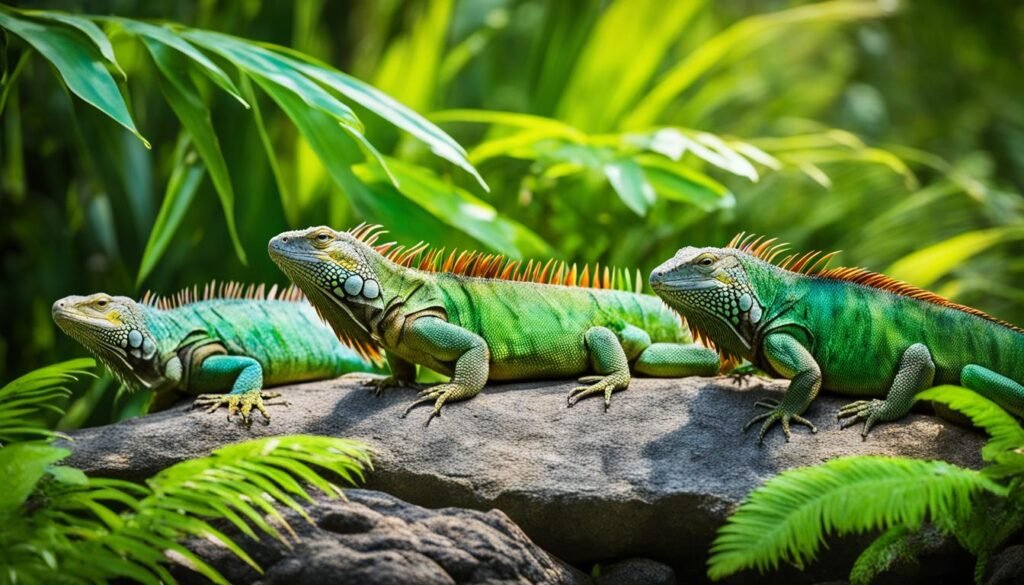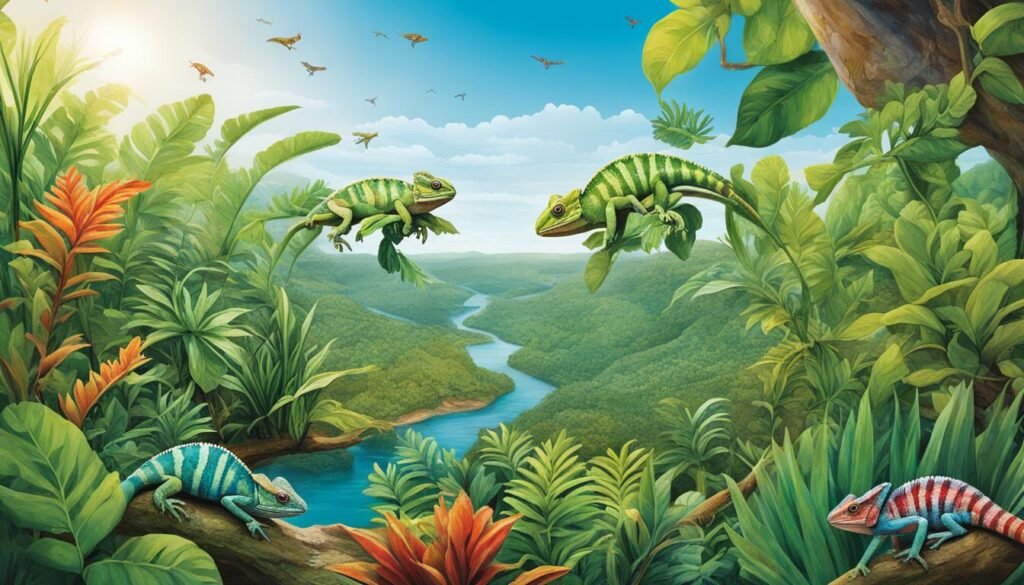Did you know that there are over 30 different species of iguanas inhabiting our planet? These fascinating reptiles, with their striking appearances and unique adaptations, captivate our imagination and play vital roles in their ecosystems.
Key Takeaways:
- Iguanas are a diverse group of reptiles, with over 30 different species.
- Each iguana species has its own distinct characteristics and adaptations.
- Iguanas play important roles in their ecosystems as herbivores and seed dispersers.
- Understanding the different species of iguanas is crucial for conservation efforts.
- Exploring the biology, behaviors, and habitats of iguanas allows us to appreciate the diversity within the reptile world.
Iguana Basics
Iguanas are fascinating reptiles that belong to the diverse family Iguanidae. They are commonly found in tropical and subtropical regions of the Americas, showcasing their remarkable adaptability. With a wide variety of species, iguanas come in various sizes and colors, captivating the eyes of enthusiasts worldwide.
One of the most striking characteristics of iguanas is their physical appearance. They possess robust bodies, sharp claws, and spiky crests that add to their captivating charm. Some iguana species display vibrant colors, such as bright greens and blues, while others have more cryptic hues that blend seamlessly with their surroundings.
Unlike other reptiles, most iguanas follow a herbivorous diet. Their main source of nutrition includes leaves, flowers, fruits, and other plant matter. Known for their basking behavior, iguanas rely on external heat sources, such as the sun, to regulate their body temperature. They can often be observed leisurely soaking up the warmth, a sight that highlights their unique adaptability.
A basking iguana showcasing its herbivorous diet and physical appearance.
Fact: Iguanas are ectothermic reptiles, meaning they rely on external heat sources to regulate their body temperature.
Iguana Species
There are numerous species of iguanas, each with its own distinct characteristics and adaptations. Some notable species include:
- Green Iguana (Iguana iguana): One of the most popular and widespread iguana species, known for their vibrant green coloration.
- Marine Iguana (Amblyrhynchus cristatus): Endemic to the Galápagos Islands, these unique iguanas have adapted to a marine lifestyle, feeding on underwater algae.
- Rock Iguana (Cyclura spp.): Endemic to the Caribbean, these iguanas thrive in rocky habitats and are known for their impressive size and strength.
- Desert Iguana (Dipsosaurus dorsalis): Found in desert regions, these iguanas are well-adapted to arid environments and have a distinctive dorsal crest.
The diverse range of iguana species highlights the incredible array of adaptations within this reptilian family.
| Species | Physical Appearance | Habitat | Diet |
|---|---|---|---|
| Green Iguana | Large size, vibrant green coloration | Tropical rainforests, riverbanks | Primarily herbivorous, feeding on leaves, fruits |
| Marine Iguana | Dark and mottled coloration, flattened body shape | Galápagos Islands | Feeds on marine algae |
| Rock Iguana | Robust build, spiny crest | Caribbean islands | Herbivorous, consuming leaves, flowers, fruits |
| Desert Iguana | Moderate size, light gray coloration | Desert regions | Primarily herbivorous, eating desert plants |
These diverse species of iguanas showcase the incredible adaptability and resilience of these reptiles in a wide range of habitats.
Fascinating Iguana Facts
Iguanas are truly remarkable creatures with unique adaptations that set them apart from other reptiles. Let’s explore some fascinating facts about these extraordinary lizards.
Marine Iguanas: Masters of the Sea
Marine iguanas are a specialized species found exclusively in the Galápagos Islands. They have evolved an incredible adaptation to their marine environment – the ability to forage for food underwater. These iguanas feed on marine algae and seaweed, making them the only known marine lizards in the world. They possess sharp claws and a streamlined body that allows them to swim effortlessly through the water.
Chameleon Iguanas: Masters of Camouflage
Some iguanas, like the Anegada iguana, have chameleon-like abilities to change their color. This remarkable adaptation helps them blend seamlessly into their surroundings, offering them protection from predators and increasing their chances of survival. These chameleon iguanas can adjust their body pigments to match the colors of their environment, making them highly elusive and difficult to spot.
The Remarkable Regeneration Power of Iguanas
Iguanas have an amazing ability to regenerate their tails. When threatened or injured, iguanas can shed their tails as a defense mechanism. The lost tail will then regrow over time, allowing the iguana to regenerate the lost appendage. This adaptation helps them escape from predators and ensures their continued survival.
An Unmatched Sense of Smell
Iguanas have an exceptional sense of smell, which plays a crucial role in their survival. Their keen olfactory abilities allow them to locate food sources, detect predators, and navigate their environment. This heightened sense of smell helps these reptiles find the freshest and most nutritious vegetation, ensuring their dietary needs are met.
These are just a few of the many fascinating facts about iguanas and their unique adaptations. Stay tuned for more intriguing details about these captivating reptiles in the upcoming sections of this article.
Wang’s Garden Lizard: A New Iguana Species
Introducing Wang’s garden lizard (Calotes wangi), a remarkable newly discovered iguana species found in the subtropical evergreen broad-leaved forests and tropical monsoon forests of southern China and northern Vietnam. Standing at less than 9 cm long, this vibrant lizard captivates with its unique characteristics and intriguing behavior.
Wang’s garden lizard boasts a stunning orange tongue, which sets it apart from other iguanas. This distinctive feature adds to its charm and allure, making it a truly remarkable creature to behold. Beyond its striking appearance, this species has a fascinating habitat and diet.
Habitat and Diet of Wang’s Garden Lizard
Wang’s garden lizard thrives in the lush environments of subtropical evergreen broad-leaved forests and tropical monsoon forests. These habitats provide the perfect conditions for the lizard’s survival and growth, offering ample vegetation, shelter, and suitable temperatures.
This iguana species is active from April to October, taking advantage of the warm seasons to explore its surroundings and indulge in its preferred diet. Wang’s garden lizard is primarily insectivorous, consuming a variety of insects, spiders, and other arthropods as its main source of sustenance.
Its diet reflects its role as a predator within the ecosystem, contributing to the regulation of insect populations and maintaining ecological balance. By preying on these small creatures, Wang’s garden lizard plays a crucial part in its habitat’s delicate web of life.
While the Wang’s garden lizard population is currently not threatened, conservation concerns have arisen due to habitat fragmentation and human exploitation. Efforts must be made to protect and preserve the environments where this unique iguana species resides, ensuring its continued existence for future generations.
This image showcases the stunning beauty of the Wang’s garden lizard, highlighting its vibrant coloration and striking features. It serves as a visual reminder of the unique and captivating characteristics of this newly discovered iguana species.
Chameleon Characteristics: A Closer Look
Chameleons are fascinating creatures with unique physical features that make them stand out among other reptiles. These characteristics play a vital role in their survival and help them thrive in their natural habitats.
One of the most notable physical features of chameleons is their bulging, rotating eyes. Their eyes can move independently, allowing them to have a 360-degree field of vision. This remarkable adaptation helps chameleons spot prey, predators, and potential mates in their surroundings.
Another distinctive feature of chameleons is their prehensile tail. This specialized tail acts as a fifth limb and helps them grip branches as they navigate through the trees. With their agile movements and strong tail, chameleons can navigate their arboreal habitats with ease.
Chameleons also have specialized feet equipped with sharp claws that enable them to cling to branches securely. These feet allow chameleons to maintain their position while they wait for unsuspecting prey to pass by, ensuring a successful capture.
One of the most fascinating aspects of chameleons is their ability to change color. This remarkable adaptation is primarily used for communication, camouflage, and temperature regulation. Chameleons can adjust their coloration to match their surroundings, making them nearly invisible to predators and prey.
Chameleons inhabit warm habitats, primarily in Africa and parts of Asia. They are arboreal, meaning they live in trees and rely on their physical features to navigate their vertical environments. These unique characteristics, along with their color-changing abilities, make chameleons one of the most intriguing reptiles in the animal kingdom.
Iguana Features: An In-depth Examination

When it comes to the physical features of iguanas, these large lizards are truly remarkable. With their robust bodies, spiky crests, and sharp claws, they possess a commanding presence in their habitats. But it’s not just their imposing appearance that sets iguanas apart – they also display a stunning array of colors. From vibrant greens to striking blues and even hints of pink, iguanas showcase nature’s vibrant palette.
These colorful aspects of iguanas serve multiple purposes. For some species, the vibrant colors act as a form of communication, helping them attract mates or establish territories. The rich pigmentation also aids in thermoregulation, allowing iguanas to absorb or reflect sunlight as needed in their various habitats.
Iguanas can be found in a wide range of habitats, adapting to diverse environments around the world. From the lush rainforests of Central and South America to the arid deserts of the Galápagos Islands, these reptiles have successfully colonized a variety of ecosystems. Their ability to climb trees and swim adds to their versatility, enabling them to navigate their chosen habitats with ease.
| Iguana Feature | Description | ||
|---|---|---|---|
| Robust Body | Iguanas have a strong, muscular body that allows them to move through various terrains. | ||
| Spiky Crest | The distinctive crests on iguanas’ heads and backs serve as both a defense mechanism and a display of dominance. | ||
| Sharp Claws | Iguanas possess sharp claws that enable them to grip surfaces firmly, whether it’s tree bark or rocky terrain. | ||
| Vibrant Colors | Iguanas come in a range of beautiful colors, which serve various purposes, including communication and thermoregulation. | ||
| Climbing Ability | Iguanas are skilled climbers, utilizing their strong limbs and sharp claws to navigate trees and other elevated structures. | ||
| Swimming Ability | Unlike many other lizards, iguanas are adept swimmers, using their long tails as propellers to propel themselves through water. |
Overall, the physical features of iguanas, combined with their colorful aspects and adaptability to different habitats, make them truly captivating creatures. Whether you encounter an iguana in the rainforest or on a tropical island, their presence is a testament to the wonders of the natural world.
Reptilian Comparison: Chameleon vs Iguana
Chameleons and iguanas are two fascinating reptiles that exhibit striking differences in their physical characteristics and behavioral patterns. Let us explore the contrasts between these remarkable creatures.
Physical Differences
Chameleons are generally smaller in size compared to iguanas. While chameleons typically measure a few inches to a foot in length, iguanas can grow up to several feet long. Additionally, chameleons have a unique body shape with a high, arched back, enabling them to navigate their arboreal habitats with ease. On the other hand, iguanas have a robust body structure, equipped with sharp claws for climbing and powerful limbs for swimming.
Color-Changing Abilities
One of the most intriguing features of chameleons is their remarkable ability to change color. They can alter their skin pigmentation to match their surroundings or as a response to environmental stimuli such as temperature, light, or mood. This exceptional color-changing trait serves various purposes, including camouflage, communication, and thermoregulation. In contrast, iguanas do not possess this color-changing ability and generally exhibit consistent skin coloration throughout their lives.
Social Behaviors
Chameleons are solitary creatures, preferring to live and hunt alone. They have minimal social interactions and only come together during mating season. In comparison, iguanas can display social behaviors, especially in the wild. They are known to form groups, bask together, and share communal nesting sites. These social bonds play a crucial role in their reproduction and survival.
In conclusion, chameleons and iguanas demonstrate notable differences in size, body structure, color-changing abilities, and social behaviors. Understanding these distinctions enhances our appreciation for the diversity and complexity of reptilian life.
Habitat Differences

Understanding the habitat preferences of chameleons and iguanas is essential to appreciate their remarkable adaptations to different environments. Chameleons primarily inhabit the lush rainforests and arid deserts of Africa, while iguanas thrive in the tropical regions of the Americas.
Chameleons have evolved to excel in arboreal environments, where they navigate the treetops with their unique climbing abilities. These reptiles are well-adapted to life among the branches, utilizing their specialized feet and prehensile tail to grip onto various surfaces. The dense canopies of rainforests and the sparse vegetation of deserts provide chameleons ample opportunities to camouflage and hide from predators.
Iguanas, on the other hand, exhibit different habitat preferences. They are often found near bodies of water such as rivers, lakes, and coastal areas. This proximity to water allows them to fulfill their need for hydration and is also crucial for their swimming abilities. Iguanas are skilled swimmers and can travel efficiently through water, utilizing their strong limbs and muscular tails.
Due to their affinity for water, iguanas are commonly spotted in diverse habitats such as mangrove swamps, tropical rainforests, and semi-arid environments. Their ability to thrive in such habitats showcases their remarkable adaptability to varying environmental conditions.
| Chameleons | Iguanas |
|---|---|
| Primarily inhabit rainforests and deserts in Africa | Native to the tropical regions of the Americas |
| Adapted to arboreal environments | Often found near water |
| Camouflage and hide among the dense vegetation | Utilize swimming abilities in aquatic habitats |
Behavioral Differences
In the realm of reptiles, chameleons and iguanas exhibit contrasting behavioral patterns that further highlight their unique characteristics. These dissimilarities can be observed in their social behavior and feeding habits.
Chameleon Behavior
Chameleons are renowned for their solitary nature, preferring to live and interact independently. They typically lead solitary lives, rarely engaging with other chameleons unless it is during the mating season. This preference for solitude is a notable aspect of their behavior, setting them apart from many other reptiles.
When it comes to feeding, chameleons display a specialized feeding habit. Primarily insectivorous, they rely on a diet consisting predominantly of insects, such as crickets and grasshoppers. Their unique feeding behavior involves using their long, sticky tongues to catch their prey with remarkable accuracy and precision.
Iguana Behavior
Unlike chameleons, iguanas can exhibit sociability, especially in the wild. Social behaviors among iguanas can be observed in their interactions, often forming groups or colonies. These social structures allow them to communicate, establish hierarchies, and partake in cooperative behaviors.
When it comes to feeding, iguanas have distinct dietary preferences. They are primarily herbivores, consuming a diet consisting mainly of plant matter, such as leaves, flowers, and fruits. This herbivorous lifestyle contributes to their role as important seed dispersers within their ecosystems.
| Chameleons | Iguanas |
|---|---|
| Solitary nature | Potential for social behavior |
| Primarily insectivorous diet | Mainly herbivorous diet |
These behavioral differences between chameleons and iguanas underscore the diversity within the reptilian world. While chameleons display an independent and insect-focused lifestyle, iguanas demonstrate social interactions and herbivorous tendencies. Understanding these behavioral distinctions enhances our appreciation for the intriguing behaviors exhibited by these reptiles.
Conclusion
Iguanas, with their diverse species, remarkable adaptations, and unique characteristics, are a source of fascination in the world of reptiles. Understanding the different iguana species, their physical traits, behaviors, and habitats is crucial for appreciating the rich reptile diversity on our planet.
By delving into the captivating world of iguanas, we gain valuable insights into the complexity and beauty of nature. From the striking coloration of some species to their herbivorous diet and basking behaviors, iguanas have evolved to thrive in their respective environments.
Appreciating the importance of understanding iguana species goes beyond mere curiosity. It plays a vital role in conservation efforts. Recognizing the diversity within the reptile world enables us to recognize the unique ecological niches that iguanas fill and their contribution to maintaining the delicate balance of ecosystems around the world.


4 thoughts on “Iguana Species: Discover Diverse Reptilian Wonders”